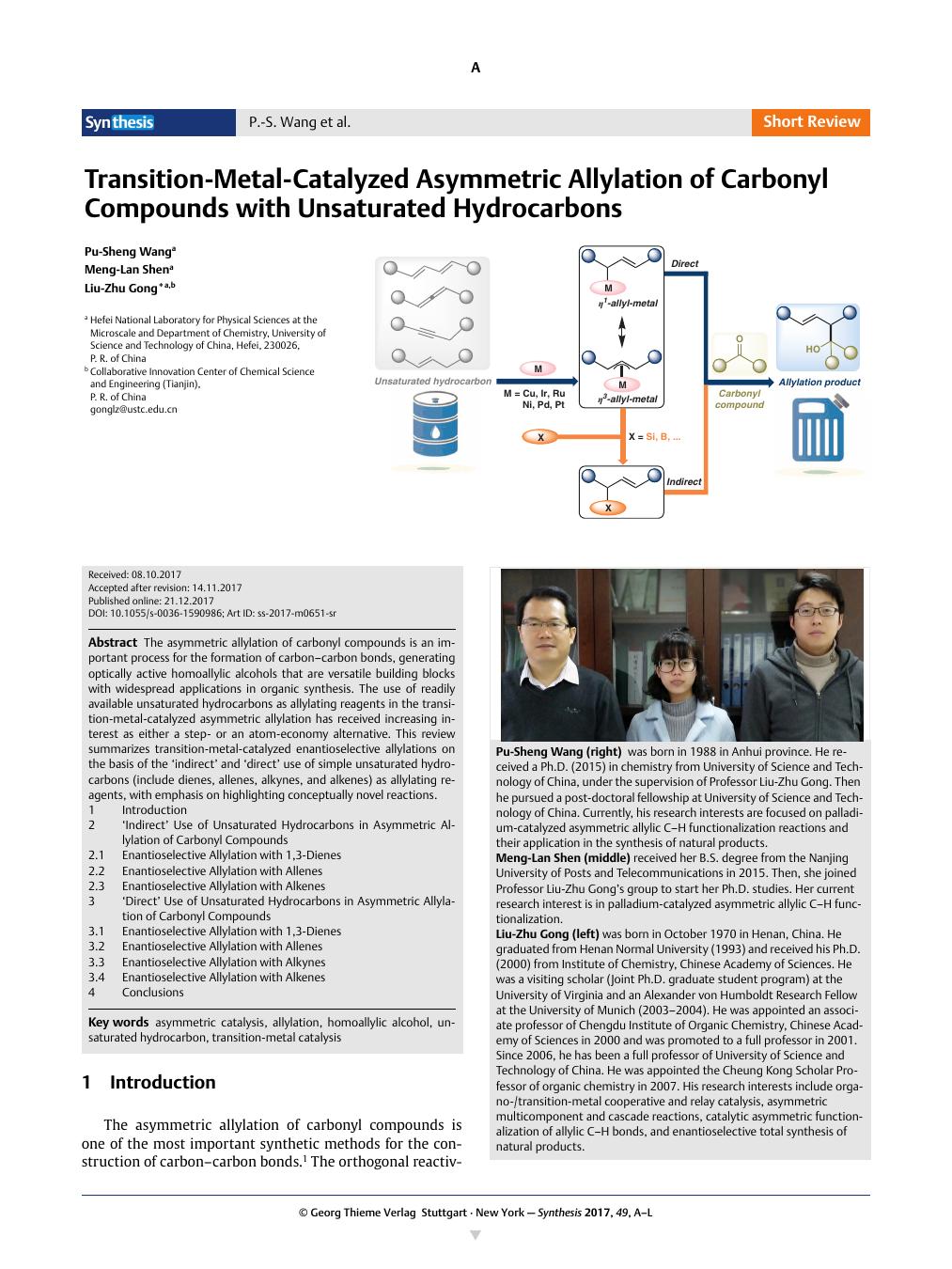Synthesis ( IF 2.6 ) Pub Date : 2017-12-21 , DOI: 10.1055/s-0036-1590986 Liu-Zhu Gong 1, 2 , Pu-Sheng Wang 1 , Meng-Lan Shen 1

|
Abstract
The asymmetric allylation of carbonyl compounds is an important process for the formation of carbon–carbon bonds, generating optically active homoallylic alcohols that are versatile building blocks with widespread applications in organic synthesis. The use of readily available unsaturated hydrocarbons as allylating reagents in the transition-metal-catalyzed asymmetric allylation has received increasing interest as either a step- or an atom-economy alternative. This review summarizes transition-metal-catalyzed enantioselective allylations on the basis of the ‘indirect’ and ‘direct’ use of simple unsaturated hydrocarbons (include dienes, allenes, alkynes, and alkenes) as allylating reagents, with emphasis on highlighting conceptually novel reactions.
1 Introduction
2 ‘Indirect’ Use of Unsaturated Hydrocarbons in Asymmetric Allylation of Carbonyl Compounds
2.1 Enantioselective Allylation with 1,3-Dienes
2.2 Enantioselective Allylation with Allenes
2.3 Enantioselective Allylation with Alkenes
3 ‘Direct’ Use of Unsaturated Hydrocarbons in Asymmetric Allylation of Carbonyl Compounds
3.1 Enantioselective Allylation with 1,3-Dienes
3.2 Enantioselective Allylation with Allenes
3.3 Enantioselective Allylation with Alkynes
3.4 Enantioselective Allylation with Alkenes
4 Conclusions
The asymmetric allylation of carbonyl compounds is an important process for the formation of carbon–carbon bonds, generating optically active homoallylic alcohols that are versatile building blocks with widespread applications in organic synthesis. The use of readily available unsaturated hydrocarbons as allylating reagents in the transition-metal-catalyzed asymmetric allylation has received increasing interest as either a step- or an atom-economy alternative. This review summarizes transition-metal-catalyzed enantioselective allylations on the basis of the ‘indirect’ and ‘direct’ use of simple unsaturated hydrocarbons (include dienes, allenes, alkynes, and alkenes) as allylating reagents, with emphasis on highlighting conceptually novel reactions.
1 Introduction
2 ‘Indirect’ Use of Unsaturated Hydrocarbons in Asymmetric Allylation of Carbonyl Compounds
2.1 Enantioselective Allylation with 1,3-Dienes
2.2 Enantioselective Allylation with Allenes
2.3 Enantioselective Allylation with Alkenes
3 ‘Direct’ Use of Unsaturated Hydrocarbons in Asymmetric Allylation of Carbonyl Compounds
3.1 Enantioselective Allylation with 1,3-Dienes
3.2 Enantioselective Allylation with Allenes
3.3 Enantioselective Allylation with Alkynes
3.4 Enantioselective Allylation with Alkenes
4 Conclusions
中文翻译:

过渡金属催化的羰基化合物与不饱和烃的不对称烯丙基化
摘要
羰基化合物的不对称烯丙基化是形成碳-碳键的重要过程,可生成光学活性均烯丙基醇,它们是在有机合成中广泛应用的通用结构单元。在过渡金属催化的不对称烯丙基化反应中,容易获得的不饱和烃作为烯丙基化试剂的使用已引起人们越来越多的兴趣,它们可以作为分步或原子经济的替代方法。这篇综述总结了过渡金属催化的对映选择性烯丙基化,其基于简单的不饱和烃(包括二烯,丙二烯,炔烃和烯烃)的``间接''和``直接''使用作为烯丙基化试剂,重点强调了概念上新颖的反应。
1引言
2在羰基化合物的不对称烯丙基化中不饱和烃的“间接”使用
2.1与1,3-二烯的对映选择性烯丙基化
2.2与烯丙烯的对映选择性烯丙基化
2.3与烯烃的对映选择性烯丙基化
3在羰基化合物的不对称烯丙基化中不饱和烃的“直接”使用
3.1与1,3-二烯的对映选择性烯丙基化
3.2与烯丙烯的对映选择性烯丙基化
3.3与炔烃的对映选择性烯丙基化
3.4与烯烃的对映选择性烯丙基化
4。结论
羰基化合物的不对称烯丙基化是形成碳-碳键的重要过程,可生成光学活性均烯丙基醇,它们是在有机合成中广泛应用的通用结构单元。在过渡金属催化的不对称烯丙基化反应中,容易获得的不饱和烃作为烯丙基化试剂的使用已引起人们越来越多的兴趣,它们可以作为分步或原子经济的替代方法。这篇综述总结了过渡金属催化的对映选择性烯丙基化,其基于简单的不饱和烃(包括二烯,丙二烯,炔烃和烯烃)的``间接''和``直接''使用作为烯丙基化试剂,重点强调了概念上新颖的反应。
1引言
2在羰基化合物的不对称烯丙基化中不饱和烃的“间接”使用
2.1与1,3-二烯的对映选择性烯丙基化
2.2与烯丙烯的对映选择性烯丙基化
2.3与烯烃的对映选择性烯丙基化
3在羰基化合物的不对称烯丙基化中不饱和烃的“直接”使用
3.1与1,3-二烯的对映选择性烯丙基化
3.2与烯丙烯的对映选择性烯丙基化
3.3与炔烃的对映选择性烯丙基化
3.4与烯烃的对映选择性烯丙基化
4。结论



























 京公网安备 11010802027423号
京公网安备 11010802027423号